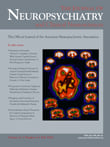Brain-Derived Neurotrophic Factor Polymorphism: More Than a Prognostic Factor During Depression?
To the Editor: Brain-derived neurotrophic factor (BDNF) is a member of the nerve growth factor family, which is widely expressed in the adult mammalian brain. Besides its critical role in the development and maintenance of neuronal systems, it is also involved in neuronal survival, proliferation, plasticity, and neurogenesis. 1
Studies indicating its role in adaptation to social stress and its association with chronic-stress-related atrophy of the limbic structures and major depressive disorder are rapidly replicating. However, considering that major depressive disorder is a heritable disorder, studies focusing on the reflection of BDNF gene functional polymorphism into the development and course of major depression are rapidly increasing. 2 , 3
Can the BDNF gene be considered as one of the multiple susceptibility genes which may play a critical role in the development and/or course of depression?
Although there are inconsistent results indicating the importance of met allele of the BDNF gene (BDNF polymorphism) on the vulnerability of depression, there is strong evidence regarding the effect of the BDNF polymorphism on cognitive performance, hippocampal volume, and the prefrontal cortex which have been implicated as important structures in mood regulation and memory. 4 , 5
In our previous study evaluating the association of the BDNF gene val66met polymorphism with the serum BDNF levels in drug-free depressed patients, we showed that depressed patients had significantly lower mean values of serum BDNF relative to the comparison group (p<0.05). Beyond suggesting a significant negative correlation between the Hamilton Depression Rating Scale (HAM-D)-17 scores and serum BDNF levels in the study group, we also showed that depressed patients with met allele had significantly lower serum BDNF levels correlated with more severe depression scores (p<0.05).
Although we failed to support the BDNF polymorphism as a susceptibility factor in major depression, our results indicated a strong link between the BDNF polymorphism, the depression severity, and the serum BDNF levels in depressed patients, which suggests its role as a prognostic factor during depression. However, the dilemma of whether the BDNF polymorphism predisposes an individual to an earlier age of developing depression or only increases the risk in the context of other genetic risk factors for depression or other hippocampal impairment should be evaluated with further neuroimaging/genetic studies, including antidepressant treatment outcomes.
1. Murer MG, Yan Q, Raisman-Vozari R: Brain-derived neurotrophic factor in the control human brain, and in Alzheimer’s disease and Parkinson’s disease. Prog Neurobiol 2001; 63:71–124Google Scholar
2. Hwang JP, Tsai SJ, Hong CJ, et al: The Val66Met polymorphism of the brain-derived neurotrophic-factor gene is associated with geriatric depression. Neurobiol Aging 2006; 27:1834–1837Google Scholar
3. Taylor WD, Züchner S, McQuoid DR, et al: Allelic differences in the BDNF val66met polymorphism in late-life depression. Am J Geriatr Psychiatry 2007 ; 10:850–857 Google Scholar
4. Hariri AR, Goldberg TE, Mattay VS, et al: Brain-derived neurotrophic factor val66met polymorphism affects human memory-related hippocampal activity and predicts memory performance. J Neuroscience 2003; 23:6690–6694Google Scholar
5. Pesawas L, Verchinski BA, Mattay VS, et al: The brain-derived neurotrophic factor val66met polymorphism and variation in human cortical morphology. J Neuroscience 2004; 24:10099–10102Google Scholar



